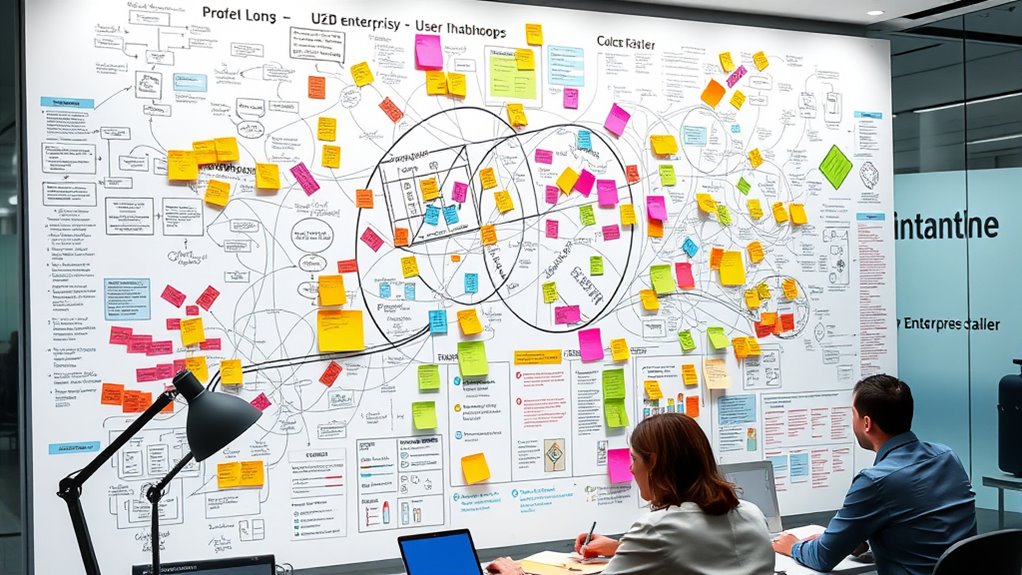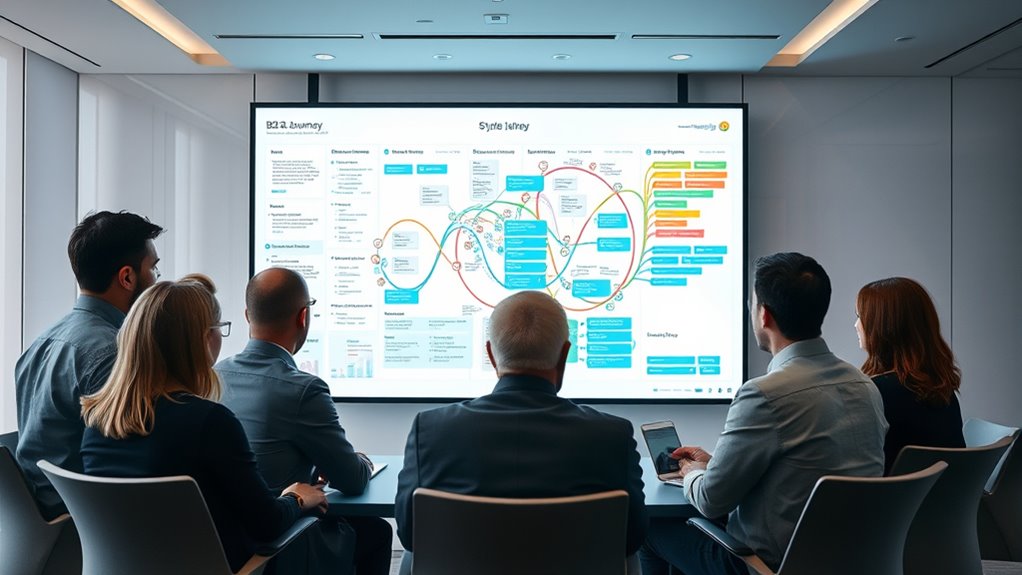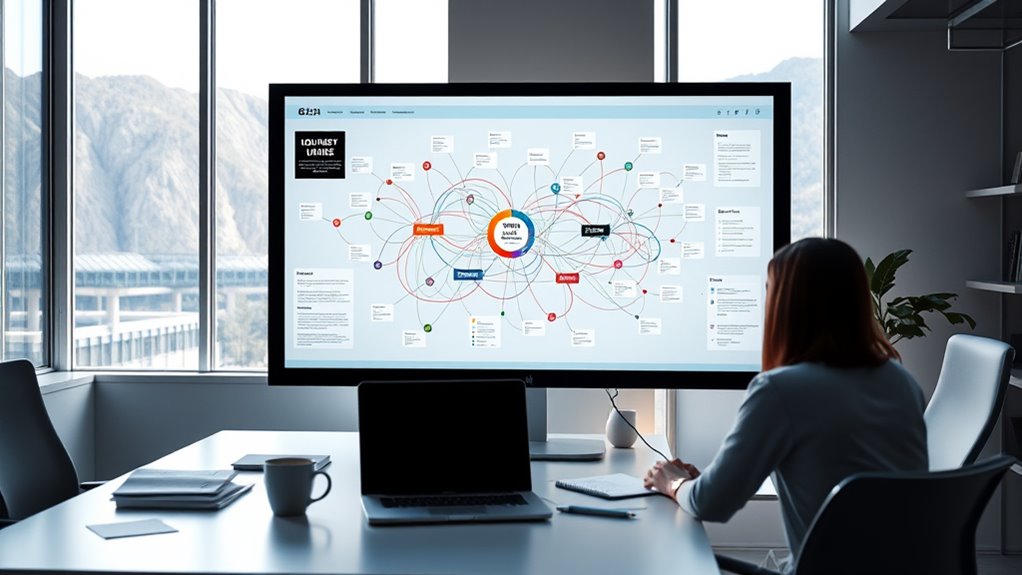In B2B enterprise environments, user journeys are complex, involving multiple departments and touchpoints. Generic personas oversimplify this, ignoring hidden stakeholder roles and unique decision processes. To truly connect, you need detailed, context-rich profiles that reflect real interactions and motivations. By understanding all involved stakeholders and leveraging data, you can craft targeted strategies that foster trust. Keep exploring to discover how accurate journey mapping transforms your engagement with enterprise users.
Key Takeaways
- Enterprise user journeys are complex, involving multiple stakeholders and touchpoints, requiring detailed mapping beyond generic personas.
- Different decision-makers have unique roles, needs, and influence, making one-size-fits-all personas ineffective.
- Cross-department collaboration and understanding emotional triggers are essential to accurately reflect enterprise interactions.
- Data-driven insights enable personalized engagement strategies that address specific stakeholder behaviors and motivations.
- Continuous updates and feedback are crucial to keep journey maps relevant, fostering trust and stronger enterprise relationships.
Understanding the Complexity of Enterprise User Journeys

Have you ever wondered why mapping enterprise user journeys is so challenging? The answer lies in the complexity of these journeys, which span multiple departments and touch various touchpoints. Achieving effective cross-department collaboration is essential, but often difficult, because each team has its own goals and processes. To truly understand enterprise users, you need to develop user empathy—seeing the journey from their perspective and recognizing their pain points across different stages. This empathy helps you piece together a cohesive experience that isn’t just siloed in one department but reflects the full scope of the user’s interactions. When you prioritize cross-department collaboration and user empathy, you gain a clearer picture of the enterprise journey’s intricate nature, making mapping more accurate and meaningful. Incorporating these elements ensures a more comprehensive bedroom view of user needs and behaviors.
The Limitations of Generic Personas in B2B Contexts

While generic personas can provide a broad understanding of customer segments, they often fall short in capturing the nuances of B2B interactions. Relying on generic targeting oversimplifies complex decision-making processes, ignoring the specific roles, priorities, and challenges of enterprise users. These personas tend to lump diverse stakeholders into a single profile, missing critical differences in how each contributes to the buying journey. This lack of detailed persona segmentation limits your ability to tailor messages and solutions effectively. In B2B, understanding the unique needs of each stakeholder is essential. Without this nuance, your strategies risk being too generic, reducing engagement and misaligning your offerings with real business needs. To succeed, you need more precise, context-rich personas that reflect the intricacies of enterprise environments.
Identifying Multiple Touchpoints and Stakeholders

To effectively map the customer journey, you need to identify all the stakeholders involved and their respective touchpoints. Recognizing key moments where interactions happen helps you understand how each stakeholder influences the process. By mapping these journeys, you can pinpoint opportunities to improve engagement and streamline decision-making. Incorporating modern farmhouse design principles can also inspire innovative approaches to space and decor, enhancing stakeholder experiences.
Mapping Stakeholder Journeys
How do you make certain you’re capturing the full scope of a stakeholder’s experience? Start by mapping their journey across all relevant touchpoints, considering both user needs and technical constraints. Recognize that stakeholders often interact with multiple departments or systems, which influences their overall experience. As you identify these interactions, focus on how each touchpoint addresses their needs and where technical limitations might hinder progress. This holistic view helps you see gaps or redundancies in their journey. By understanding the diverse stakeholders involved, you ensure your mapping reflects real-world complexities, enabling you to optimize processes, improve engagement, and deliver a seamless experience. Accurate stakeholder journey mapping ultimately leads to more targeted solutions that meet enterprise goals and user expectations. Additionally, incorporating an understanding of emotional support can help identify areas where stakeholders may need reassurance or reassurance during complex processes.
Recognizing Key Touchpoints
Identifying key touchpoints requires you to pinpoint where stakeholders interact with your organization across various channels and systems. By analyzing user behavior, you can see which moments influence their perceptions and decisions. These touchpoints include website visits, customer support interactions, product usage, and sales meetings. Recognizing these critical moments helps you understand how stakeholders engage at different stages of their journey. When you map these touchpoints, you also uncover opportunities to reinforce brand loyalty by delivering consistent, personalized experiences. Keep in mind that multiple stakeholders may interact with your organization through different channels, so understanding their unique touchpoints assures you address their specific needs. Additionally, considering how automation technology can streamline engagement at these touchpoints enhances the efficiency and effectiveness of your journey mapping. This approach helps build stronger relationships and guides you toward more effective, targeted engagement strategies.
Recognizing Unique Decision-Making Processes

You need to understand that decision-making processes vary greatly across organizations, influenced by different stakeholders. These influences can complicate the purchase cycle, making it longer and more strategic. Recognizing these unique processes helps you tailor your approach and improve your chances of success. For example, understanding the brewing techniques employed by different teams can reveal their priorities and decision criteria.
Varied Stakeholder Influences
Have you ever considered how different stakeholders in a B2B journey each have their own decision-making styles? Recognizing these varied influence dynamics is vital for stakeholder alignment. Some stakeholders rely on data and logic, while others prioritize relationships or risk mitigation. By understanding their unique motivations and decision criteria, you can craft better engagement strategies. You’ll see how influence flows differently—sometimes top-down, other times through peer consensus—shaping the overall purchasing process. Addressing these differences ensures your messaging resonates with each stakeholder’s priorities, fostering collaboration and reducing friction. Ultimately, appreciating these varied influences helps you map more accurate journeys, enabling smoother alignment and more successful outcomes in complex B2B environments. Additionally, understanding the role of decision-making factors in the process can further refine your approach.
Complex Purchase Cycles
Why do some B2B purchase cycles stretch over months or even years? It’s because decision-making involves multiple user personas, each with unique roles and priorities. These complex cycles require thorough evaluation, negotiations, and approvals, often influenced by emotional drivers like risk aversion or trust. You can’t treat enterprise users as just another persona; their emotional drivers shape their perceptions and decisions throughout the process. Recognizing these factors helps you understand why the journey isn’t linear. You need to map out not only the rational steps but also the emotional triggers that impact each stakeholder’s commitment. Incorporating spiritual decor elements can foster a sense of trust and positive energy within the decision-makers, subtly influencing their perceptions. By doing so, you’ll better anticipate delays, tailor your messaging, and build relationships that guide the decision toward a successful close, even after months of deliberation.
Leveraging Data to Map Real User Experiences

Leveraging data to map real user experiences allows you to gain a clear, objective view of how customers interact with your business at every touchpoint. By integrating data from multiple sources, you can accurately differentiate personas, revealing nuanced behaviors that generic profiles overlook. Data integration ensures you capture the full scope of user interactions across channels, providing a thorough picture of their journey. This approach helps you identify patterns, pain points, and moments of engagement that are critical for refining your strategies. Instead of relying on assumptions, you base your journey map on actual behaviors and preferences. Understanding the importance of regular maintenance and troubleshooting in managing complex systems can help you anticipate issues before they impact the user experience. Ultimately, this empowers you to create more precise, targeted experiences that resonate with enterprise users and foster stronger relationships.
Crafting Tailored Engagement Strategies

Once you understand your customers’ behaviors and preferences through detailed journey mapping, the next step is to craft engagement strategies that resonate on a personal level. Focus on creating emotional engagement by addressing their specific needs, pain points, and motivations. Personalization strategies should go beyond generic messages; tailor content, offers, and interactions to each enterprise user’s unique context. Use insights from your journey maps to anticipate their expectations and deliver relevant experiences at every touchpoint. This targeted approach builds trust and fosters deeper relationships, increasing loyalty and satisfaction. Remember, the goal isn’t just to inform but to connect emotionally, making your engagements feel meaningful and purposeful. Incorporating mindful engagement techniques enhances your ability to build genuine connections and align your strategies with users’ values and expectations. Well-executed tailored strategies turn routine interactions into impactful moments that strengthen your brand’s relationship with enterprise users.
Measuring Success and Evolving Your Journey Maps

To guarantee your journey maps remain effective, it’s essential to establish clear metrics for measuring success and regularly update them based on new insights. Pay close attention to emotional drivers, which reveal how your users feel at each touchpoint, helping you gauge engagement and satisfaction. Cultural impacts also shape user behavior, so tracking changes in organizational culture or industry trends ensures your maps stay relevant. Use feedback, analytics, and qualitative data to identify patterns and shifts over time. Regular reviews help you refine personas, uncover unmet needs, and adapt strategies accordingly. Incorporating content analysis can further enhance your understanding of user interactions and preferences. By continuously evolving your journey maps, you better understand your enterprise users’ evolving expectations, ultimately fostering stronger relationships and more successful outcomes.
Frequently Asked Questions
How Can Journey Maps Adapt to Rapid Organizational Changes?
When organizational changes happen quickly, you must keep your journey maps flexible to stay relevant. Embrace organizational agility by regularly updating your maps to reflect new processes and goals. Encourage employee adaptation by gathering ongoing feedback and monitoring shifting touchpoints. This way, your journey maps evolve with your organization, helping you understand user needs, improve experiences, and maintain a competitive edge despite rapid change.
What Tools Best Capture Complex Enterprise User Behaviors?
You need tools that capture user behavior, visualize data effectively, and adapt to complexity. Platforms like heatmaps and session recordings provide insights into user actions, while analytics dashboards and behavioral tracking tools offer real-time data visualization. These tools help you understand nuanced enterprise behaviors, enabling you to make informed decisions. By combining these, you get an all-encompassing view that reveals patterns, highlights pain points, and guides strategic improvements in your user journey.
How Do Cultural Differences Influence B2B Journey Mapping?
You should recognize that cultural differences greatly influence B2B journey mapping by shaping cross-cultural nuances and regional preferences. These factors impact how enterprise users communicate, make decisions, and prioritize features. By understanding these variations, you can tailor your approach to different markets, ensuring your strategies resonate locally. Adapting your journey maps to reflect cultural contexts helps you create more accurate, effective solutions that address diverse enterprise user needs.
What Role Does Technology Integration Play in User Experience?
Technology integration plays a vital role in enhancing user experience by allowing you to leverage detailed user personas and data integration. When you seamlessly connect systems, you can personalize interactions, streamline workflows, and anticipate needs more accurately. This creates a smoother journey for users, reduces friction, and boosts satisfaction. As you optimize these integrations, your understanding of user behaviors deepens, helping you deliver tailored solutions that meet enterprise users’ complex demands effectively.
How Can Feedback Loops Improve Ongoing Journey Mapping Accuracy?
Think of feedback loops as the compass guiding your journey mapping efforts. You actively gather feedback validation from users, ensuring your insights stay on course. By continuously engaging users, you keep their experiences at the heart of your map, refining it with real-time input. This ongoing dialogue boosts accuracy, helping you adapt to evolving needs and build a more precise, user-centric journey that truly resonates with enterprise users.
Conclusion
Think of your enterprise users as intricate mazes, each turn revealing new insights and challenges. By understanding their unique paths, you can light the way with tailored strategies that resonate deeply. Like a skilled cartographer, you’ll navigate their complex terrain, turning scattered data into a clear map. Embrace this journey mapping approach, and watch your engagement flourish like a vibrant ecosystem thriving in harmony. Your success depends on truly knowing the paths they walk.









